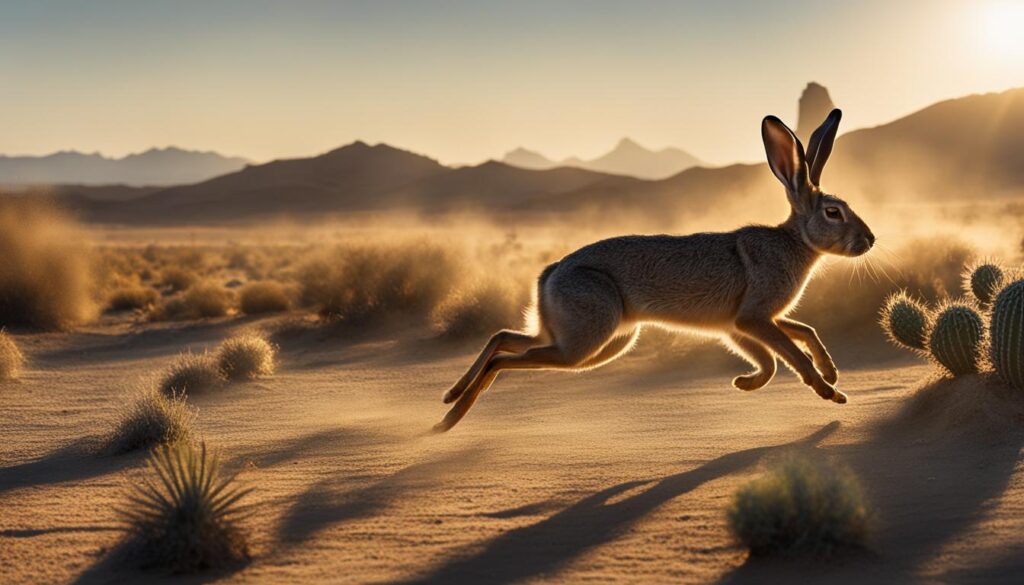Jackrabbits, belonging to the hare family and not actual rabbits, are fascinating creatures found in North America. They are known for their incredible speed, adaptability to arid environments, and unique physical features such as large ears and strong hind legs. Let’s dive into the world of jackrabbits to explore their fast-paced lifestyle and interesting traits.
Key Takeaways:
- Jackrabbits are a species of hare, not rabbits.
- They are fast-running animals and are known for their long jumps.
- Jackrabbits are herbivorous mammals and primarily eat grasses, leaves, twigs, and seeds.
- They have adapted to arid environments with features like large ears for heat regulation and 360-degree vision.
- Jackrabbits are indigenous to North America and are considered part of its diverse wildlife.
Identifying Features of Jackrabbits
Jackrabbits, specifically the black-tailed jackrabbits (Lepus californicus), are easily recognizable for their distinct features. One of their most notable characteristics is their large ears, which help them regulate their body temperature in the hot desert climates they inhabit. Additionally, they have long legs and black-tipped tails, giving them a unique appearance within the rabbit species.
These identifying features serve important functions in the jackrabbit’s survival. The large ears not only aid in heat dissipation but also provide exceptional hearing capabilities, allowing them to detect potential predators. The long legs enable them to achieve impressive speeds when running, reaching up to 40 miles per hour in short bursts to evade threats. The black-tipped tails are believed to serve as a visual cue during their high-speed escapes, helping to confuse predators and divert their attention.
To summarize, jackrabbits can be distinguished by their large ears, long legs, and black-tipped tails. These features contribute to their unique appearance and play a vital role in their ability to thrive in arid environments.
Adaptations of Jackrabbits
Jackrabbits have evolved unique adaptations that allow them to thrive in arid environments. One of their most prominent features is their large ears, which serve multiple purposes.
Their large ears not only aid in dissipating heat from their bodies, helping them regulate their internal temperature in hot climates, but they also enhance their hearing capabilities. With exceptional auditory senses, jackrabbits can detect potential predators and other sounds in their surroundings.
Another fascinating adaptation of jackrabbits is their 360-degree vision. Their eyes are positioned on the sides of their head, providing them with a wide field of view. This visual adaptation allows them to have a broader perspective, making it easier to spot potential dangers from all directions while foraging or navigating their environment.
Adaptations of Jackrabbits
Jackrabbits have evolved several adaptations that enable them to thrive in arid environments. Their large ears serve a dual purpose – not only do they aid in dissipating heat from their bodies, but they also provide exceptional hearing capabilities, helping them detect potential predators. Moreover, the positioning of their eyes on the sides of their head, along with a slightly flattened head, grants them almost 360-degree vision.
These adaptations contribute to the jackrabbits’ survival in harsh desert conditions. By effectively regulating their body temperature and having an extensive field of view, jackrabbits are well-equipped to navigate their environment and avoid threats.
“The large ears and 360-degree vision of jackrabbits are remarkable examples of nature’s adaptations to the challenges of arid environments.” – Wildlife biologist
Overall, the adaptations of jackrabbits highlight their remarkable ability to thrive in the arid landscapes they inhabit. Through their large ears and 360-degree vision, these fascinating creatures have developed strategies to regulate their body temperature and detect potential dangers in their surroundings, ensuring their survival in challenging environments.
| Adaptation | Description |
|---|---|
| Large Ears | Aid in heat dissipation and enhance hearing capabilities |
| 360-Degree Vision | Eyes positioned on the sides of their head, providing a broad field of view |
Habitat and Range of Jackrabbits
Jackrabbits are highly adaptable creatures that can thrive in various habitats, but they particularly favor open flat places such as desert scrub and mesquite grasslands. These environments provide them with the necessary space to maneuver and escape from predators. The unique ability of jackrabbits to survive in such arid conditions is a testament to their remarkable adaptations.
In the vast regions of North America, from Baja California and south-central Mexico to the western parts of the United States, jackrabbits can be found roaming freely. Their range extends across diverse landscapes, including deserts, grasslands, and even agricultural areas. Their presence in these regions contributes to the rich biodiversity of the North American wildlife.
While jackrabbits are known for their ability to withstand harsh conditions, they do have specific preferences within their habitat. They tend to favor areas with ample vegetation, as this provides them with abundant food sources. These herbivorous mammals rely on the availability of grasses, leaves, clover, and other plant materials to sustain their diet.
Jackrabbits Habitat and Range:
| Habitat | Main Characteristics |
|---|---|
| Open Flat Places | Provide necessary space for maneuverability |
| Desert Scrub | Adapted to arid conditions with limited water sources |
| Mesquite Grasslands | Abundant vegetation for food sources |
Jackrabbits’ ability to survive and thrive in different environments makes them an essential part of the ecosystem. Their presence in open spaces, such as desert scrub and mesquite grasslands, contributes to the overall balance of the natural world.
The Diet of Jackrabbits
Jackrabbits, as herbivores, have a varied diet consisting of grasses, leaves, clover, alfalfa, twigs, seeds, beans, and even cacti. Their ability to consume a wide range of plant materials is essential for their survival in arid environments where food sources may be limited. Let’s explore the different components of a jackrabbit’s diet in more detail:
- Grasses: Jackrabbits rely heavily on grasses as a staple food source. They graze on various types of grasses, including native grasses found in their habitats.
- Leaves: In addition to grasses, jackrabbits also consume leaves from a variety of plants. They feed on the leaves of shrubs and low-lying vegetation.
- Clover and Alfalfa: These leguminous plants are an important part of a jackrabbit’s diet. They provide essential nutrients and are often sought after by jackrabbits.
- Twigs: Jackrabbits will browse on twigs and small branches, especially during times when other food sources are scarce.
- Seeds and Beans: Jackrabbits have a knack for finding and consuming seeds and beans. They play an important role in seed dispersal as they consume these plant reproductive structures and distribute them across their habitats.
- Cacti: While not a regular part of their diet, jackrabbits are known to eat cacti, especially during periods when water is scarce. Their ability to consume spiny plants showcases their adaptability to arid environments.
By having such a diverse diet, jackrabbits are able to extract the necessary nutrients from the plants around them, even in harsh desert conditions, ensuring their survival in their unique habitats.
Predators of Jackrabbits
Jackrabbits play a vital role in the food chain as they serve as a significant food source for various predators. The open flat spaces and desert habitats that jackrabbits prefer also make them vulnerable to predation. Here are some of the primary predators that target jackrabbits:
- Coyotes: These canines are highly adapted to hunting small mammals and are known to pursue and capture jackrabbits with their speed and agility.
- Hawks and Eagles: Birds of prey such as Red-tailed Hawks and Ferruginous Hawks, as well as eagles, have keen eyesight and aerial capabilities that enable them to spot and pursue jackrabbits from above.
- Foxes and Bobcats: These cunning predators are opportunistic hunters and will prey on jackrabbits when given the chance.
- Humans: While not a natural predator, humans have historically hunted jackrabbits for their meat and fur, contributing to their population decline in some areas.
The speed and agility of jackrabbits are their primary defense mechanisms against these predators. When threatened, they rely on their powerful hind legs to execute long leaps and quick sprints, making it challenging for predators to catch them.
“The open flat spaces and desert habitats that jackrabbits prefer also make them vulnerable to predation.”
It is important to note that while predators pose a threat to jackrabbits, they also play a crucial role in maintaining ecological balance. Keeping the population of jackrabbits in check helps prevent overgrazing and allows other species to coexist in their shared habitats.
| Predator | Notes |
|---|---|
| Coyotes | Highly adapted to hunting small mammals, they are one of the primary predators of jackrabbits. |
| Hawks and Eagles | Birds of prey with keen eyesight and aerial capabilities; they can spot and pursue jackrabbits from above. |
| Foxes and Bobcats | Cunning and opportunistic hunters that will prey on jackrabbits when given the opportunity. |
| Humans | While not a natural predator, human hunting has contributed to the decline of jackrabbit populations in certain areas. |
Behavior and Reproduction of Jackrabbits
Jackrabbits exhibit fascinating behaviors and unique reproductive habits that contribute to their survival in the wild. These behaviors include group resting and a distinct approach to reproduction. Let’s delve into these aspects and learn more about the intriguing world of jackrabbits.
Group Resting
One intriguing behavior of jackrabbits is their tendency to engage in group resting. Jackrabbits are social animals, and they often gather in small groups to rest. This behavior serves multiple purposes for their survival. By resting together, they can rely on the collective eyes and ears of their companions to detect potential predators. Additionally, group resting allows them to conserve energy and regulate their body temperatures by sharing body heat.
Reproduction
Unlike rabbits, jackrabbits do not live in burrows. Instead, they create shallow nests called forms in tall grasses or thick vegetation to give birth to their young. Female jackrabbits can have multiple litters per year, with each litter consisting of one to six young, known as leverets. Leverets are born with fur and their eyes open, making them more independent from an early age compared to other rabbit species.
The reproductive strategy of jackrabbits is influenced by their harsh and unpredictable environment. By having multiple litters, they increase the chances of successfully passing on their genes, ensuring the survival of their species even in challenging conditions.
Table: Comparing Rabbit and Jackrabbit Reproduction
| Rabbits | Jackrabbits |
|---|---|
| Live in burrows | Do not live in burrows |
| Have multiple burrows for different purposes | Create shallow nests called forms for giving birth |
| Have smaller litters | Can have multiple litters per year |
| Young are born hairless and blind | Leverets are born with fur and eyes open |
In conclusion, the behavior and reproduction of jackrabbits showcase their unique adaptability and strategies for survival in their arid environments. Group resting enables them to protect themselves and conserve energy, while their reproductive habits, such as multiple litters per year and independent leverets, increase their chances of thriving in challenging conditions. These remarkable behaviors and reproductive traits contribute to the enduring presence of jackrabbits in the diverse wildlife of North America.
Size and Lifespan of Jackrabbits
Adult black-tailed jackrabbits typically weigh between 3 to 7 pounds and measure about two feet in length. These large hares have a slender body with long legs, enabling them to reach impressive speeds when evading predators. In the wild, their average lifespan ranges from 2 to 5 years. However, when kept in a zoological setting, they tend to live longer.
Compared to other rabbit species, jackrabbits are notably larger and heavier. Their size and weight contribute to their ability to cover long distances quickly and efficiently. With their powerful hind legs and lightweight bodies, they can easily leap several feet in a single bound. This physical prowess makes them well-suited for their fast-paced lifestyle in the North American wild.
While their size and lifespan can vary slightly depending on factors such as habitat and availability of resources, black-tailed jackrabbits typically fall within the aforementioned range. These incredible creatures demonstrate the remarkable adaptations and characteristics that allow them to survive and thrive in their diverse environments.
| Species | Weight (pounds) | Length (feet) | Lifespan (years) |
|---|---|---|---|
| Black-tailed Jackrabbit | 3 – 7 | 2 | 2 – 5 |
| White-tailed Jackrabbit | 6 – 10 | 2 – 2.5 | 2 – 5 |
Table: Comparison of size, weight, length, and lifespan between two jackrabbit species.
Fun Facts about Jackrabbits
Jackrabbits are not just ordinary rabbits; they are actually a species of hare. Unlike rabbits, their young, called leverets, are born with fur and their eyes already open, making them more independent from birth. These unique characteristics distinguish jackrabbits from their fluffy-tailed counterparts.
One of the most remarkable aspects of jackrabbits is their incredible speed. When startled, they can reach speeds of up to 40 mph in short bursts, allowing them to evade potential predators. This impressive running ability is one of the reasons why jackrabbits are so fascinating to observe in their natural habitats.
“Jackrabbits are a true testament to the adaptability of hare species,” says Dr. Emily Rodriguez, wildlife biologist and jackrabbit expert. “Their fast running and unique physical features, such as their long legs and large ears, are adaptations that have helped them thrive in their environments.”
In summary, jackrabbits are hare species with fun and intriguing facts. They are born with fur and open eyes, distinguishing them from rabbits. Their incredible speed, reaching up to 40 mph, allows them to escape from predators. With their unique adaptations and striking physical features, jackrabbits continue to captivate the imagination of wildlife enthusiasts worldwide.
The White-Tailed Jackrabbit
The white-tailed jackrabbit is a subspecies of jackrabbit that holds the title for being the largest member of the rabbit and hare family. Weighing between 6 to 10 pounds, these jackrabbits are truly impressive in size. However, it’s not just their size that sets them apart; their running style is also quite unique. When startled, they exhibit a running style reminiscent of a kangaroo, with powerful leaps and bounds propelling them forward.
One fascinating aspect of white-tailed jackrabbits is their ability to change color in winter. As the snow blankets their habitat, these jackrabbits undergo a transformation, turning white to blend in seamlessly with their wintry surroundings. This adaptation allows them to effectively camouflage themselves from predators and increases their chances of survival in the harsh winter months.
To further explore the distinct characteristics and features of the white-tailed jackrabbit, refer to the table below:
| Characteristic | Description |
|---|---|
| Size | The white-tailed jackrabbit is the largest member of the rabbit and hare family, weighing between 6 to 10 pounds. |
| Running Style | When startled, white-tailed jackrabbits exhibit a running style similar to that of a kangaroo, using powerful leaps and bounds to navigate their environment. |
| Winter Coloration | These jackrabbits undergo a color change in winter, turning white to blend in with the snowy landscape and increase their chances of survival. |
The white-tailed jackrabbit’s impressive size, unique running style, and ability to change color in winter make it a truly remarkable member of the rabbit and hare family. These adaptations allow them to thrive in their habitats and navigate the challenges posed by their environment.
Conservation Status of Jackrabbits
Jackrabbits, particularly the black-tailed jackrabbit subspecies, are not considered threatened or endangered. However, it is important to note that the Tehuantepec jackrabbit, another subspecies of jackrabbit, is categorized as near threatened. This distinction highlights the need for conservation efforts to protect this specific population.
Other species of jackrabbits found in various regions of Mexico, the United States, and Canada are generally classified as least concern in terms of their conservation status. While they may not currently face immediate threats, it is still crucial to prioritize their preservation to ensure the long-term sustainability of their habitats and populations.
“Conservation efforts should focus on preserving the diversity of jackrabbit species and their habitats,” emphasizes Dr. Sarah Johnson, a wildlife conservation expert. “Maintaining healthy ecosystems, such as desert scrub and grasslands, is essential for the survival of jackrabbits and other wildlife.”
Continued monitoring and research are necessary to better understand the specific needs and threats faced by different jackrabbit species. By gaining a deeper understanding of their ecology, behavior, and interactions with their environment, conservationists can develop targeted strategies to protect these unique and fascinating creatures for future generations.
| Species | Conservation Status |
|---|---|
| Black-tailed Jackrabbit (Lepus californicus) | Not Threatened |
| Tehuantepec Jackrabbit (Lepus flavigularis) | Near Threatened |
| Other Jackrabbit Species | Least Concern |
Conclusion
Jackrabbits are truly fascinating wildlife species found in the diverse landscapes of North America. Their unique adaptations, such as large ears for heat regulation and 360-degree vision, allow them to thrive in arid environments. These fast-running creatures, belonging to the hare family, captivate wildlife enthusiasts with their impressive speed and agility.
By exploring the world of jackrabbits, we gain a deeper understanding and appreciation for their remarkable characteristics. Their herbivorous diet, ability to survive in limited food sources, and their important role in the food chain as prey for predators contribute to their significance in North American ecosystems.
Whether it’s their physical features, behavior, or reproductive patterns, jackrabbits continue to intrigue researchers and nature lovers alike. Their presence in regions from Mexico to the United States and Canada adds to the rich biodiversity of North America’s wildlife. Studying and appreciating these fascinating creatures offers a glimpse into the wonders of the natural world.
FAQ
Are jackrabbits actually rabbits?
No, jackrabbits are not actual rabbits. They are hares that belong to the hare family.
What are the distinguishing features of jackrabbits?
Jackrabbits have large ears, long legs, and black-tipped tails.
How do jackrabbits adapt to arid environments?
Jackrabbits have large ears that help regulate their body temperature and provide exceptional hearing capabilities. Their eyes are positioned on the sides of their head, granting them almost 360-degree vision.
Where can jackrabbits be found?
Jackrabbits are found in various habitats in North America, including desert scrub and mesquite grasslands.
What do jackrabbits eat?
Jackrabbits are herbivorous mammals and primarily feed on grasses, leaves, clover, alfalfa, twigs, seeds, beans, and even cacti.
What predators do jackrabbits have?
Jackrabbits are hunted by animals such as coyotes, Red-tailed Hawks, Ferruginous Hawks, eagles, foxes, bobcats, and humans.
What are some interesting behaviors of jackrabbits?
Jackrabbits exhibit behaviors such as group resting and do not live in burrows like rabbits. Female jackrabbits give birth to multiple litters per year, and the young, called leverets, are born with fur and their eyes open.
How big do jackrabbits get and how long do they live?
Adult black-tailed jackrabbits typically weigh between 3 to 7 pounds and measure about two feet in length. In the wild, their average lifespan ranges from 2 to 5 years.
What are some fun facts about jackrabbits?
Jackrabbits are actually hares, not rabbits. They can reach speeds of up to 40 mph in short bursts and baby jackrabbits are called leverets.
Tell me about the white-tailed jackrabbit.
The white-tailed jackrabbit is the largest member of the rabbit and hare family. It has a unique running style resembling that of a kangaroo when startled, and it undergoes a color change in winter, turning white to blend in with the snow.
What is the conservation status of jackrabbits?
While black-tailed jackrabbits are not considered threatened or endangered, the Tehuantepec jackrabbit subspecies is categorized as near threatened. Other species of jackrabbits in Mexico, the United States, and Canada are generally classified as least concern in terms of conservation status.





